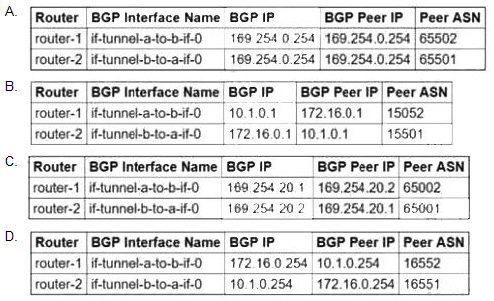
PROFESSIONAL-CLOUD-NETWORK-ENGINEER Exam Questions & Answers
Exam Code: PROFESSIONAL-CLOUD-NETWORK-ENGINEER
Exam Name: Professional Cloud Network Engineer
Updated: Nov 10, 2024
Q&As: 170
At Passcerty.com, we pride ourselves on the comprehensive nature of our PROFESSIONAL-CLOUD-NETWORK-ENGINEER exam dumps, designed meticulously to encompass all key topics and nuances you might encounter during the real examination. Regular updates are a cornerstone of our service, ensuring that our dedicated users always have their hands on the most recent and relevant Q&A dumps. Behind every meticulously curated question and answer lies the hard work of our seasoned team of experts, who bring years of experience and knowledge into crafting these premium materials. And while we are invested in offering top-notch content, we also believe in empowering our community. As a token of our commitment to your success, we're delighted to offer a substantial portion of our resources for free practice. We invite you to make the most of the following content, and wish you every success in your endeavors.

Download Free Google PROFESSIONAL-CLOUD-NETWORK-ENGINEER Demo
Experience Passcerty.com exam material in PDF version.
Simply submit your e-mail address below to get started with our PDF real exam demo of your Google PROFESSIONAL-CLOUD-NETWORK-ENGINEER exam.
![]() Instant download
Instant download
![]() Latest update demo according to real exam
Latest update demo according to real exam
* Our demo shows only a few questions from your selected exam for evaluating purposes
Free Google PROFESSIONAL-CLOUD-NETWORK-ENGINEER Dumps
Practice These Free Questions and Answers to Pass the Google Certifications Exam
You deployed a hub-and-spoke architecture in your Google Cloud environment that uses VPC Network Peering to connect the spokes to the hub. For security reasons, you deployed a private Google Kubernetes Engine (GKE) cluster in one of the spoke projects with a private endpoint for the control plane. You configured authorized networks to be the subnet range where the GKE nodes are deployed. When you attempt to reach the GKE control plane from a different spoke project, you cannot access it. You need to allow access to the GKE control plane from the other spoke projects. What should you do?
A. Add a firewall rule that allows port 443 from the other spoke projects.
B. Enable Private Google Access on the subnet where the GKE nodes are deployed.
C. Configure the authorized networks to be the subnet ranges of the other spoke projects.
D. Deploy a proxy in the spoke project where the GKE nodes are deployed and connect to the control plane through the proxy.
You are deploying a global external TCP load balancing solution and want to preserve the source IP address of the original layer 3 payload. Which type of load balancer should you use?
A. HTTP(S) load balancer
B. Network load balancer
C. Internal load balancer
D. TCP/SSL proxy load balancer
You need to configure the Border Gateway Protocol (BGP) session for a VPN tunnel you just created between two Google Cloud VPCs, 10.1.0.0/16 and 172.16.0.0/16. You have a Cloud Router (router-1) in the 10.1.0.0/16 network and a second Cloud Router (router-2) in the 172.16.0.0/16 network. Which configuration should you use for the BGP session?

A. Option A
B. Option B
C. Option C
D. Option D
Your company recently migrated to Google Cloud in a Single region. You configured separate Virtual Private Cloud (VPC) networks for two departments. Department A and Department B. Department A has requested access to resources that are part Of Department Bis VPC. You need to configure the traffic from private IP addresses to flow between the VPCs using multi-NIC virtual machines (VMS) to meet security requirements Your configuration also must
1.
Support both TCP and UDP protocols
2.
Provide fully automated failover
3.
Include health-checks
Require minimal manual Intervention In the client VMS
Which approach should you take?
A. Create the VMS In the same zone, and configure static routes With IP addresses as next hops.
B. Create the VMS in different zones, and configure static routes with instance names as next hops
C. Create an Instance template and a managed instance group. Configure a Single internal load balancer, and define a custom static route with the Internal TCP/UDP load balancer as the next hop
D. Create an instance template and a managed instance group. Configure two separate internal TCP/IJDP load balancers for each protocol (TCP!UDP), and configure the client VIVIS to use the internal load balancers' virtual IP addresses
You work for a university that is migrating to Google Cloud.
These are the cloud requirements:
On-premises connectivity with 10 Gbps
Lowest latency access to the cloud
Centralized Networking Administration Team
New departments are asking for on-premises connectivity to their projects. You want to deploy the most cost-efficient interconnect solution for connecting the campus to Google Cloud.
What should you do?
A. Use Shared VPC, and deploy the VLAN attachments and Dedicated Interconnect in the host project.
B. Use Shared VPC, and deploy the VLAN attachments in the service projects. Connect the VLAN attachment to the Shared VPC's host project.
C. Use standalone projects, and deploy the VLAN attachments in the individual projects. Connect the VLAN attachment to the standalone projects' Dedicated Interconnects.
D. Use standalone projects and deploy the VLAN attachments and Dedicated Interconnects in each of the individual projects.
Viewing Page 1 of 3 pages. Download PDF or Software version with 170 questions

